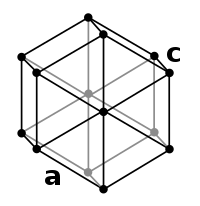
Photo from wikipedia
Abstract In this study a series of CuO-ZnO-Al 2 O 3 -ZrO 2 nanocatalysts were prepared using hydrothermal, thermochemical, coprecipitation and hybrid coprecipitation-plasma methods. The impacts of argon glow discharge… Click to show full abstract
Abstract In this study a series of CuO-ZnO-Al 2 O 3 -ZrO 2 nanocatalysts were prepared using hydrothermal, thermochemical, coprecipitation and hybrid coprecipitation-plasma methods. The impacts of argon glow discharge plasma on physicochemical properties and performance of nanocatalysts in methanol steam reforming for H 2 production were investigated. The samples were characterized using XRD, FESEM, EDX, BET and FTIR techniques. According to XRD patterns, the peaks intensity of the plasma-treated sample were decreased and a little widened, possibly due to smaller particle size and better particle dispersion. The FESEM images showed no evident agglomeration on the surface of plasma-treated sample and good dispersion of this sample was noticed in EDX results. Besides, according to BET analysis, this nanocatalyst had higher specific surface area than other samples. Smaller particle size, more uniform distribution of particles and higher surface area, resulting from the glow discharge plasma treatment, caused higher hydrogen yield and methanol conversion at all temperatures. Consequently, methanol conversion for plasma-treated sample reached 100% at 240 °C and the performance of this sample remained constant for a duration of 24 h.
Journal Title: Ceramics International
Year Published: 2017
Link to full text (if available)
Share on Social Media: Sign Up to like & get
recommendations!